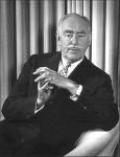Florence, near present-day Omaha, August 1856
Where Two Lines Raced To Drive The Last Spike In Transcontinental Track
If you were asked to name pivotal meetings in American history, the linking of the Union Pacific and Central Pacific railroads might not immediately come to mind. But it was perhaps the most important. Before the completion of the transcontinental railroad in 1869, it took months to get from coast to coast, and more than $1,000. After these two lines met at Promontory Summit in northern Utah, a New Yorker could travel to California in a week for as little as $70.
The truth is still emerging about the mass murder of more than 100 California-bound emigrants in Utah in 1857, and about the role of leaders of the Mormon Church in the atrocity.
On August 3, 1999, a backhoe operator powered his shovel into a hard-packed mound of earth at a remote site in the southwestern corner of Utah, and to the shock of those watching, the bucket emerged with more than 30 pounds of human skeletons.
Retracing the Pioneer Trail in Mormon Utah
On my first visit to Gilgal Garden, a back-yard collection of folk sculpture in Salt Lake City, a Mormon friend who shares my taste for the unusual took my picture.
Discovering a giant in the family
Emerson wrote that “there is properly no history; only biography,” so my brother and sister and I knew that the revered collection of diaries and papers that had once belonged to our grandfather, which during most of our early lives was in a closet in an upst
Much has changed in Utah since World War II, but outside of the metropolitan center in the Salt Lake Valley, the addiction to rural simplicity and the idea of home is still strong.
Saltair, the stately pleasure dome that used to rise out of the waters of Great Salt Lake, was the Coney Island of the West.
The Utah Photographs of George Edward Anderson
When George Edward Anderson was born at Salt Lake City in 1860, Brigham Young’s desert kingdom—“the resting place of Israel for the last days”—still stood defiantly apart from the rest of America, embattled and alone.
From Poverty and Persecution to Prosperity and Power
In the month of February, 1846, when conditions for travel were as unpropitious as possible, the Mormons began moving out of their newly built city of Nauvoo, Illinois, in order to cross the ice-strewn Mississippi, on the first leg of a long and uncertain journey.
In the red-rock country of southeastern Utah is a new national park, a quarter-million acres of silence, brilliant color, and vistas unmatched anywhere on Earth.
The Mormons grow in numbers, but persecution makes them wanderers. Then a burst of violence results in
THE MORMONS—PART II





